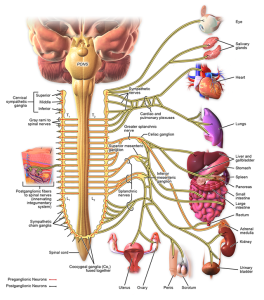Sympathetic Nervous System
Jim Hutchins
Objective 2: Discuss the key features of the sympathetic division of the autonomic nervous system.
Sympathetic Nervous System
| Sympathetic Nervous System
*Sweat glands are an exception that we will not consider |
|||||
|---|---|---|---|---|---|
| Preganglionic cell body location | Length of preganglionic axon | Preganglionic neurotransmitter (signaling molecule) | Postganglionic cell body location | Length of postganglionic axon | Neurotransmitter (signaling molecule) released onto effector organ |
| Lateral horn of spinal cord (T1 – L2) | Short | Acetylcholine | Chain ganglion near spinal cord | Long | Norepinephrine (noradrenaline)* |

The sympathetic nervous system, sometimes called the “fight-flight-freeze” system, is tuned to activate the entire body at once. The preganglionic cell bodies are located in the lateral part of the gray matter at the first thoracic level (T1) through the second lumbar level (L2) of the spinal cord. These neurons send out short axons which enter the nearby sympathetic chain ganglia where they release acetylcholine onto the postganglionic neurons. The axon of the postganglionic neurons travels a long distance to the organs where it releases norepinephrine (noradrenaline) onto smooth or cardiac muscle.
 Let’s say a tiger entered the room where you were reading this. What would you need to do? Your pupils would dilate, your mouth would go dry, your heart rate would increase, the air passages of the lungs would dilate to take in more air, and you would sweat. All these functions are controlled by norepinephrine released from the postganglionic neurons of the sympathetic nervous system. At the same time, the digestive organs would shut down and as much blood as possible would be shunted to the skeletal muscles so you could run if needed.
Let’s say a tiger entered the room where you were reading this. What would you need to do? Your pupils would dilate, your mouth would go dry, your heart rate would increase, the air passages of the lungs would dilate to take in more air, and you would sweat. All these functions are controlled by norepinephrine released from the postganglionic neurons of the sympathetic nervous system. At the same time, the digestive organs would shut down and as much blood as possible would be shunted to the skeletal muscles so you could run if needed.
The response of the nervous system generally is too quick and transient to run for very far or for very long. The sympathetic nervous system also stimulates a gland on top of the kidney, the adrenal medulla, to release epinephrine (adrenaline) which travels in the bloodstream and activates the same receptor as norepinephrine.
Noradrenaline or norepinephrine? Adrenaline or epinephrine?
You might have noticed, and been confused by, the interchangeability of the terms “adrenaline” and “epinephrine” and the similar terms “noradrenaline” and “norepinephrine“.
The “nor–” prefix is the easiest one to deal with. Adrenaline is made by adding a methyl (–CH3) group to noradrenaline.
Both noradrenaline and adrenaline bind to the same receptor, called the adrenergic receptor.
In general, noradrenaline is used as a neurotransmitter, released from noradrenergic neurons. In general, adrenaline is a hormone, released into the bloodstream from the adrenal medulla.
Adrenaline is chemically identical to the signaling molecule epinephrine. Thus, in clinical practice, we use an “EPIPEN®” which is a trademarked name for an autoinjector syringe loaded with epinephrine. The EPIPEN® is used to treat a life-threatening allergic reaction called anaphylaxis which we’ll discuss further in Unit 15.
How did we get in this situation? No one knows, and no one seems to be able to do anything about it. The terms mean the same thing (ad– and epi– mean “on top of”; renal and nephr are root words which both mean kidney). Apparently, a group of scientists refused to adopt the other group’s preferred name at the beginning of the 20th century so the name used depends on which group you affiliated with.
Adrenaline = epinephrine
Noradrenaline = norepinephrine
Both signaling molecules act at adrenergic receptors
Media Attributions
- Sympathetic Innervation © BruceBlaus is licensed under a CC BY (Attribution) license
- Shita and her new tiger friends attack © Haakon Lie is licensed under a CC BY-ND (Attribution NoDerivatives) license

